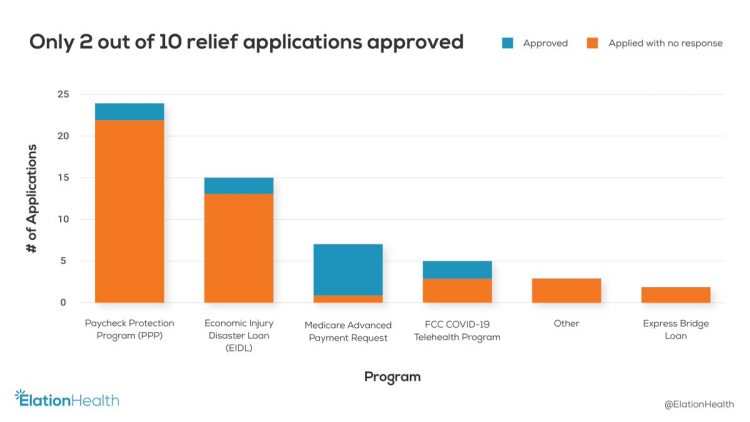Is help actually getting to primary care practices on the front-lines?

Is help actually getting to primary care practices on the front-lines? Only 21% of applications for COVID-19 financial aid have been approved from taking a closer look with Elation’s independent primary care practices.
We tracked 56 applications for COVID financial relief across 35 medical practices. Of those, only 12 had been approved and funded as of late April.

PPP, EIDL and Express Bridge Loan programs were least likely to work. Medicare Advance Payment applications were the most likely (before that program was canceled).
The Small Business Administration PPP loan program performed badly for our primary care practices, with only 8% of applications being approved and funded in the first round. A new wave of these loans did happen over the weekend, so we may have some more success to report coming soon.
Medicare Advance Payment requests through CMS were the most responsive with 85% of requests being quickly approved and funded for our primary care practices.
After approving 24,000 applications, CMS canceled the program. As Ayla Ellison reported, physicians are already asking for it to be restarted and expanded.
The $200 million FCC COVID-19 Telehealth program has so far only funded less than half (40%) of the applications we tracked.
Surprising to see practices only applied for so few programs each, given their levels of hardship we’ve seen and reported by the Primary Care Collaborative, Partnership to Empower Physician-Led Care, the AAFP, and acific Business Group on Health.
We saw only three applications and zero funded for the other relief programs through payers, private foundations and states.
It’s not often I recommend webinars but you should hear from these front line physicians trying to keep their practices open. Worth an hour of hour shelter in place time and worth our collective action. We can’t open our economy if people aren’t healthy https://t.co/qZ6ofWyD8k
— Elizabeth Mitchell (@lizzymitch2) May 3, 2020
Without the Medicare Advance Payment program from CMS, the approval rate for these funding applications drops to just 12%. A discouraging rate for primary care practices already juggling a lot with COVID-19 patient care and financial hardship.






